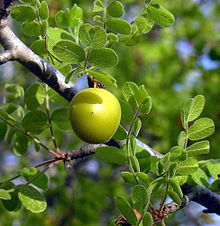| Cimarrón plum | |
|---|---|

| |
| The drupe | |
| Scientific classification | |
| Kingdom: | Plantae |
| Clade: | Tracheophytes |
| Clade: | Angiosperms |
| Clade: | Eudicots |
| Clade: | Rosids |
| Order: | Sapindales |
| Family: | Anacardiaceae |
| Genus: | Cyrtocarpa |
| Species: | C. edulis |
| Binomial name | |
| Cyrtocarpa edulis (T. S. Brandegee) Standley, 1923 | |
| Synonyms | |
|
Tapirira edulis T. S. Brandegee | |
Cyrtocarpa edulis is a species of perennial sarcocaulescent tree commonly known as the Cimarrón plum or Cape wild-plum. It is in the genus Cyrtocarpa, and is endemic to Baja California Sur. This plant is characterized by fleshy stems, twisted branches and an edible drupe.
Description

These spreading trees or shrubs may grow 5 to 8 meters in height with smooth, light-grey bark and have a thick, succulent trunk that can reach 2⁄3 m in diameter. Plants on sand dunes may grow in a prostrate habit. The leaves are pinnately compound, and 4 to 10 cm long, composed of 7 to 11 ovate or elliptic shaped leaflets. The dioecious flowers are white and tinged with green, the female flowers with 5 petals 1.5 to 3 mm long. The fruit is an oblong to ovoid shaped drupe, 1.5 to 2 cm long, and green to yellow when ripe.
Taxonomy
Two varieties of this species are recognized:
- Cyrtocarpa edulis var. edulis — Commonly known as the Cape wild-plum. The autonymous variety, with dense pubescence (hairs; trichomes) on the leaves, flowers, and fruits.
- Cytrocarpa edulis var. glabra León de la Luz & Pérez Navarro — Commonly known as the Cape smooth wild-plum. This variety is characterized by a lack of trichomes (glabrous condition) on the leaves, flowers, and fruits. Both varieties are sympatric with each other, but var. glabra has a more restricted range, mostly along the Pacific coast.
Distribution and habitat
This species most commonly occurs in the Cape Region of Baja California Sur, but may be found in the mountain ranges from the southern Sierra de la Giganta to Los Cabos. It also occurs on the adjacent islands of San Jose, Espiritu Santo, and Cerralvo in the southern Gulf of California. This plant is commonly found on sandy plains and slopes, and often in arid, tropical forests or in areas of deep soil in the mountains. It is intolerant of shade in the foothills, and is sensitive to low winter temperature in the highlands.
Uses
This species has been introduced into horticultural circles via the Huntington Botanical Gardens International Succulent Introductions program in 2021. It can be propagated from both seed or cuttings, as the branches may be sufficiently succulent to root.
The edible fruit is used locally. The drought-tolerant nature of this species may make it a viable fruit crop for arid land.
References
- ^ León de la Luz, José Luis; Pérez Navarro, José Juan (2007). "A new variety of Cyrtocarpa edulis (Anacardiaceae)". Acta Botánica Mexicana. 79. eISSN 2448-7589 – via SciELO.
- Brandegee, Townshend Stith (1 September 1900). "A New Tapirira from Baja California". Zoe. 5: 78–79.
- ^ Rebman, J. P.; Gibson, J.; Rich, K. (2016). "Annotated checklist of the vascular plants of Baja California, Mexico" (PDF). San Diego Society of Natural History. 45: 32.
- "ISI 2021-14. Cyrtocarpa edulis Standl". International Succulent Introductions of the Huntington Botanical Gardens. Huntington Library. 2021. Archived from the original on 2022-01-10. Retrieved 9 January 2021.
- Leon, Jose Luis; Troyo-Dieguez, Enrique (June 1992). "Preliminar Studies on 'Cimarron' Wild Plum as a New Fruit Crop for Arid Lands". HortScience. 27 (6): 639e–639. doi:10.21273/HORTSCI.27.6.639e.
External links
 Media related to Cyrtocarpa edulis at Wikimedia Commons
Media related to Cyrtocarpa edulis at Wikimedia Commons Data related to Cyrtocarpa edulis at Wikispecies
Data related to Cyrtocarpa edulis at Wikispecies
| Taxon identifiers | |
|---|---|
| Cyrtocarpa edulis | |
| Tapirira edulis | |